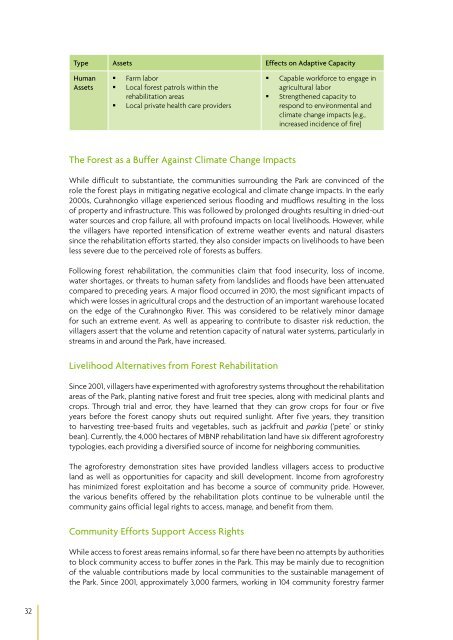Adaptation case studies.pdf - RECOFTC
Adaptation case studies.pdf - RECOFTC
Adaptation case studies.pdf - RECOFTC
Create successful ePaper yourself
Turn your PDF publications into a flip-book with our unique Google optimized e-Paper software.
Type Assets Effects on Adaptive CapacityHumanAssets• Farm labor• Local forest patrols within therehabilitation areas• Local private health care providers• Capable workforce to engage inagricultural labor• Strengthened capacity torespond to environmental andclimate change impacts (e.g.,increased incidence of fire)The Forest as a Buffer Against Climate Change ImpactsWhile difficult to substantiate, the communities surrounding the Park are convinced of therole the forest plays in mitigating negative ecological and climate change impacts. In the early2000s, Curahnongko village experienced serious flooding and mudflows resulting in the lossof property and infrastructure. This was followed by prolonged droughts resulting in dried-outwater sources and crop failure, all with profound impacts on local livelihoods. However, whilethe villagers have reported intensification of extreme weather events and natural disasterssince the rehabilitation efforts started, they also consider impacts on livelihoods to have beenless severe due to the perceived role of forests as buffers.Following forest rehabilitation, the communities claim that food insecurity, loss of income,water shortages, or threats to human safety from landslides and floods have been attenuatedcompared to preceding years. A major flood occurred in 2010, the most significant impacts ofwhich were losses in agricultural crops and the destruction of an important warehouse locatedon the edge of the Curahnongko River. This was considered to be relatively minor damagefor such an extreme event. As well as appearing to contribute to disaster risk reduction, thevillagers assert that the volume and retention capacity of natural water systems, particularly instreams in and around the Park, have increased.Livelihood Alternatives from Forest RehabilitationSince 2001, villagers have experimented with agroforestry systems throughout the rehabilitationareas of the Park, planting native forest and fruit tree species, along with medicinal plants andcrops. Through trial and error, they have learned that they can grow crops for four or fiveyears before the forest canopy shuts out required sunlight. After five years, they transitionto harvesting tree-based fruits and vegetables, such as jackfruit and parkia (‘pete’ or stinkybean). Currently, the 4,000 hectares of MBNP rehabilitation land have six different agroforestrytypologies, each providing a diversified source of income for neighboring communities.The agroforestry demonstration sites have provided landless villagers access to productiveland as well as opportunities for capacity and skill development. Income from agroforestryhas minimized forest exploitation and has become a source of community pride. However,the various benefits offered by the rehabilitation plots continue to be vulnerable until thecommunity gains official legal rights to access, manage, and benefit from them.Community Efforts Support Access RightsWhile access to forest areas remains informal, so far there have been no attempts by authoritiesto block community access to buffer zones in the Park. This may be mainly due to recognitionof the valuable contributions made by local communities to the sustainable management ofthe Park. Since 2001, approximately 3,000 farmers, working in 104 community forestry farmer32
















